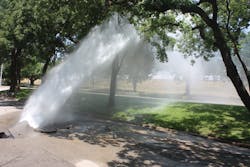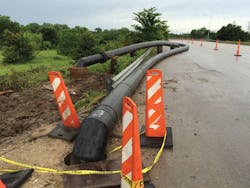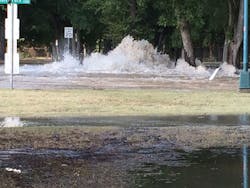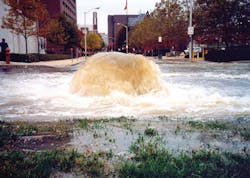By Alanna Maya
Loss of public confidence in your utility can be devastating and it can take years to regain credibility and trust. The relationship between utilities and the communities and people they serve depends upon the proper handling of emergency situations. That is why it’s crucial to have a crisis communications plan in place before issues arise. Having a plan and a trained, skilled staff person for dealing with day-to-day occurrences, as well as major emergencies, is as important as having a capital spending plan. This article will discuss the key components and examples of effective crisis communications.
A crisis plan includes all the guidelines for dealing with a crisis, whatever it may be (main break, boil water notice, water quality issues, etc.). The crisis communications plan can be part of your overall crisis plan, but it should be a separate plan, with the utility’s decision-making and responses written down and ready so that the people at the helm can guide that communications plan and process.
In February, Marci Davis, manager of infrastructure and strategic communications at Jacobs Engineering, spoke at the AWWA/WEF Utility Management Conference in San Diego, Calif., about the importance of having a communications plan in place before problems arise.
“One of the key things that instills public confidence in a utility during a crisis is the consistency [of the message], and people coming up and doing what they say they are going to do,” she said. “Consistency and transparency and keeping that going … will help you talk about the situation [at hand], focus your key messages and set up protocols.”
Davis currently works directly with several Atlanta-area utility clients to develop and implement strategic communications plans. The public’s perception of an agency, she said, has less to do with the fact that crises happen and more to do with how the agency responds.
“We see it all the time and it’s the response that makes all the difference,” she said. “Bad situations are going to happen and the public is going to find out. Everyone has a cell phone, and people are automatically posting to social media; so how you respond will really make a difference.”
Responding to a crisis in a timely manner is almost as important as the message you wish to convey. Any delays can have a detrimental effect on public confidence and trust. To this end, a crisis communications plan that lays out all possible scenarios and corresponding responses, kept in an easy-to-access, central location, can make all the difference.
It is never too early to start thinking about what can go wrong or to run possible crisis communications scenarios at your utility, Davis suggested. Even so, you might not think of all the possible scenarios that could arise.
“Although you can try to think of everything, that is not always possible,” said Mary Gugliuzza, media relations and communications coordinator with the Fort Worth (Texas) Water Department. “There will always be some other kind of twist that comes up that you didn’t think about.”
Gugliuzza has been with Fort Worth Water for 20 years, but things still manage to surprise her, she said. Unforeseen events are an opportunity to add to your crisis communications plan, and when one of these things actually happens, you get to practice it, she said.
For example, in July 1998, Fort Worth Water had a 36-inch water line rupture just outside its oldest water treatment plant. In that case, the street was actually higher in elevation than the plant, so the water ran back into the plant and flooded the pump station and filter wings for that facility. The incident caused the city to instantly lose 80 million gallons of treatment capacity overnight during a high-use time of year. Getting the message out to residents in the middle of the night was a difficult task. According to Gugliuzza, the morning news media played a key role in informing residents to restrict water use to only essential indoor uses until the pump station could be repaired.
There are a few key steps to building an appropriate crisis response. First, identify the situation and what information you wish to convey to the public about the event. Ask the following questions: What do you hope to achieve from your communication efforts? Who are you sending the messages to? What are the key messages you want to convey in this situation? How are you going to disseminate those messages, especially as channels continue to expand under the realm of social media?
During a recent boil water notice in Fort Worth, the city used Nixle, an alert notification platform that enables communities to disseminate information through email or text. During this particular incident, Nixle’s partnership with Google created an interesting wrinkle: Google started sending out alerts by zip code, but the boil water notice only covered small portions of certain zip codes. Customers weren’t reading the alerts accurately, and people who were actually not covered by the boil water notice began calling Forth Worth Water, confused about whether or not their homes were affected.
“So many utilities forget to communicate with their own employees,” Gugliuzza said. “We operate a call center in Fort Worth, and people mostly call with billing questions - but not always. Sometimes they report main breaks or outages, and you want to make sure that if folks are calling in, your staff knows what it is they should be saying, and that they have the talking points they need to update and answer customer questions.”
But it’s not just the call center employees who need to know what the utility’s response is. All employees have families and neighbors who know where they work, Gugliuzza pointed out, and they are likely to get questions when they get home. Other parties who should be on the utility’s communications list include the news media, elected officials, first responders, regulators, and wholesale customers, if any.
Whoever the utility selects to speak on their behalf should feel comfortable in front of the news media and be properly briefed on the current situation. This person’s role is to provide the facts and deliver a consistent message. He or she should be someone who can remain calm and speak with authority. Other agencies might be involved, so there might be multiple spokespeople for the situation, but they should all be on the same page and saying the same thing.
If necessary, consider providing media training for employees who might be called upon to speak for the utility. In the event that your spokesperson is out of town or unreachable during a crisis, Gugliuzza recommends having three backups.
The message should focus on three things: express concern, establish control and tell people what you are doing to correct the situation. If the opportunity presents itself, you can give the public something to do - people feel more in control if they have direction, Gugliuzza advised.
“When you are putting together your plan, ask the hard questions because someone else will,” she said. “You never want to go into a media briefing thinking, ‘I hope they aren’t going to ask that,’ and don’t ever say ‘no comment.’ You can say it without saying it, but don’t ever use those two words because it will sound like you haven’t got the situation under control.” Instead, Gugliuzza suggested saying, ‘We are not allowed to comment on personnel issues,’ or ‘At this point, our priority is X and we will look into Y later.’
“The more you repeat the same thing - your key messages - the more confident you will sound,” she said, “and then the media has nothing else to use but that sound bite or video; in turn, helping to reinforce your message to the public.”
Having a variety of communication tools is important. Regarding Fort Worth’s communications plan, Gugliuzza said the utility uses the news media primarily to communicate to the public, but it also uses social media quite a bit. “The city has a good database of neighborhood organizations and homeowner’s associations so we use that to communicate with the affected areas as well.”
At the Utility Management Conference in February, Kelsey Ewart, public outreach officer for Canada’s Niagara Region, echoed the important role social media can play in communicating to customers during a crisis - but only if those channels are already established with your audience.
“You can’t expect to just open a Facebook or Twitter account for your utility or organization and go forth,” she said. “You need to have the audience in place before an event happens, so that during a crisis, people will receive your message. While the crisis is happening, monitor and respond to messages through social media to make sure that people are receiving accurate information in a timely manner.”
Ewart said clear, concise messages are key. For example, in the event of a boil water advisory, a social media post linking to the locations where people can get clean, usable water can be very effective.
“I think the challenge is that in every one of these situations, there is always someone who will complain because they didn’t know [what was happening],” Gugliuzza said. “You can only make the channels available; if people don’t take advantage of the communications options at their disposal, it’s hard to get a message to everyone.”
Likewise, during normal, day-to-day operations (absent any incidents), it is important for utilities to keep the lines of communication open so that customers’ feelings of confidence in the utility are renewed and strengthened. Participating in city-run events, like community fairs, is one example of how a utility could stay in the public eye. An annual water quality report is another.
“Like all water utilities, Fort Worth Water shares its annual water quality report with the public, and we use our report to communicate information beyond just the required water quality data,” Gugliuzza said. “We also try to engage our customers with social media to let them know what’s going on and we offer educational classes - about gardening and outdoor water use, for instance - to engage our customers so that they can get to know us.” Gugliuzza added that Fort Worth Water also has a speaker’s bureau comprised of spokespeople who can go out and give talks to neighborhood or civic organizations to establish a rapport with customers.
After crisis communications have occurred, there is more that can be done. Both Davis and Gugliuzza recommended a debrief with key staff members to assess the utility response after the fact, and suggested sharing those findings with utility employees in the days and weeks after an incident has been resolved to increase learning opportunities.
“Look for areas where you can revise your plan and fill holes,” Davis said. “Let people know about any changes or revisions you have made [so that a future incidents will be handled correctly] in a timely manner.” And, she added, don’t forget to thank your customers.
For utilities looking to build a crisis communications plan, a public communications toolkit is available from AWWA (www.awwa.org). This free resource includes templates and talking points available for downloading.
Above all, Gugliuzza said, be prepared. Build relationships with third parties, and work through your crisis scenarios ahead of time. The last thing you want to do is add to the unknown during a crisis situation.
Alanna Maya is the assistant editor for WaterWorld and Industrial WaterWorld magazines. Reach her at [email protected].
Importance of an SSO Emergency Contingency Plan
The EPA estimates as many as 75,000 sanitary sewer overflows (SSOs) happen every year. Widespread weather events often trigger SSOs in multiple communities simultaneously, so it could be difficult to secure the pumping equipment and support you need without a plan in place.
What Is a Contingency Plan?
It is an incredibly important document that reduces stress, by proactively identifying:
- Equipment your community needs to mitigate an SSO
- 24/7 contact info for your Xylem Emergency Team
- Directions to your location
Why Would I Need a Contingency Plan?
While you may not have had an SSO in the recent past, changing weather patterns are making them more likely. In fact, about two thirds of the U.S. is experiencing much greater than average rainfall per event now than just 20 years ago.
What Should I Have in My Contingency Plan?
Specific situations may differ but, generally, if your pump station is taken offline by direct flooding, or by interruption of its power source, an emergency bypass pumping system will keep your wastewater flowing properly.
An SSO Contingency Plan is like insurance: You hope you never need it, but when you do it’s invaluable. A contingency plan ensures that with just one phone call - day or night - you’ll be mitigating the problem in hours instead of days, or even weeks. Connect with Xylem for more info at xylem.com/GetPlan.
About the Author

Alanna Maya
Chief Editor
Alanna Maya is a San Diego State University graduate with more than 15 years of experience writing and editing for national publications. She was Chief Editor for WaterWorld magazine, overseeing editorial, web and video content for the flagship publication of Endeavor's Water Group. In addition, she was responsible for Stormwater magazine and the StormCon conference.





